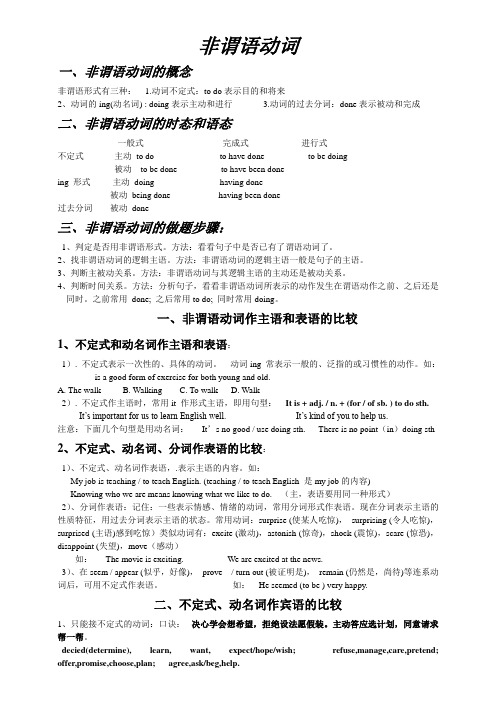非谓语动词(复习to do和doing介绍done )
- 格式:ppt
- 大小:373.50 KB
- 文档页数:35


to do doing done 非谓语用法
“To do, doing, done”是英语中一种非常常见的非谓语用法,是指以“to do”、“doing”和“done”开头的动词不定式、现在分词和过去分词形式。
在句子中,这个结构通常用于表示某个特定的动作或状态,而不涉及主谓关系。
下面我们来详细了解一下这三种非谓语用法的具体用法。
一、to do
“To do”是动词不定式,它的基本结构是“to + 动词原形”。
在句子中,“to do”通常用于表示将要发生的动作或未完成的动作。
具体用法如下:
1. 表示目的:例如:
- I went to the store to buy some groceries.(我去商店买食材。
)
- She went to the library to study. (她去图书馆学习。
)
- He called me to ask for some advice.(他打电话给我问建议。
)
二、doing
综上所述,“to do, doing, done”三种非谓语用法在英语中应用广泛,能够帮助我们表达各种场景下的动作或状态。
熟练掌握这三种非谓语用法,能够让我们的语言表达更加丰富和准确。

高考英语语法核心考点专项复习08:非谓语动词非谓语动词是动词的一大分类,是高中阶段考察最多也是最难的知识点,是学生头疼的一大难题。
本专题从非谓语的分类、判定、用法、题型和考点来讲解,并配以习题练习。
目的:掌握非谓语的形式,学会判别谓语与非谓语,熟练常考题型和用法。
一、非谓语动词分类现在分词doing过去分词done不定式to do动名词doing二、判断非谓语动词非谓语动词作为动词的形式变化,无法充当句子中的谓语动词,因为非谓语动词没有时态的变化。
非谓语动词三种基本形式:to do(不定式),doing(动名词/现在分词),done(过去分词)【精讲精练】请分别找出谓语动词和非谓语动词。
swim,drunk,observed,playing,done,conduct,read,come,having finished,having been done谓语动词:________________________________________________________________非谓语动词:______________________________________________________________【小试牛刀】一. 请用不同标记分别画出下列句子中的非谓语动词和谓语动词。
1. The remaining twenty patients were transferred to another hospital.2. I rea lly understood the meaning of the proverb, “Helping others is the source of happiness.”3. We should lay more emphasis on protecting the surroundings.二. 请用不同标记画出文章中的谓语动词和非谓语动词。
With curiosity, we listened attentively, asking questions and taking notes. The camel ride on the third day was surely the most exciting part of our tour. Looking far into the desert, I pictured how ancient Chinese travelled along the Silk Road. How time flew! Soon it was the last day of our tour. At the train station, we took a p hoto holding a banner with “ Cultural Tour along the Silk Road” on it.二. 非谓语动词的主被动上面讲解了三大基本非谓语动词的主动形式,下面对于每种形式的被动形式进行列举:【精讲精练】请写出下面非谓语动词对应的主动形式/被动形式。

非谓语动词非谓语动词包括不定式(to do)、动名词(-ing)、现在分词(-ing)与过去分词(-ed)。
动词不定式不定式的句法功能:1、作主语:To finish the work in ten minutes is very hard.动词不定式短语作主语时,常用it作形式主语,真正的主语不定式置于句后,例如上面两句可用如下形式:It is very hard to finish the work in ten minutes.It means failure to lose your heart.常用句式有:1、It+be+名词+to do。
2、It takes sb.+some time+to do。
3、It+be+形容词+of sb +to do。
4 It+be+形容词+for sb.+to do。
常用careless,,clever,good,foolish,honest,kind,lazy,nice,right,silly,stupid,wise,等表示赞扬或批评的形容词,不定式前的sb.可作其逻辑主语。
2、作表语:Her job is to clean the hall.3、作宾语:口诀决心学会想希望,decide/ determine, learn, want, expect/hope/wish拒绝设法愿假装;refuse, manage, care, pretend主动答应选计划,offer/order, promise, choose, plan,同意请求帮一帮。
agree, ask/beg, help如果不定式(宾语)后面有宾语补足语,则用it作形式宾语,真正的宾语(不定式)后置,放在宾语补足语后面,例如:Marx found it important to study the situation in Russia.动词不定式也可充当介词宾语,如:I have no choice but to stay here.He did nothing last Sunday but repair his bike.动词不定式前有时可与疑问词连用,如:He gave us some advice on how to learn English.4、作宾语补足语:在复合宾语中,动词不定式可充当宾语补足语,如下动词常跟这种复合宾语:want, wish, ask, tell, order, beg, permit, help, advise, persuade, allow, prepare, cause, force, call on, wait for, invite.此外,介词有时也与这种复合宾语连用,如:With a lot of work to do, he didn't go to the cinema.有些动词如在使役动词make, have, let和感官动词see, watch, notice, observe, feel, hear, listen to, look at等词后接不定式作宾补,不定式不带to,表示做某事的全过程。

非谓语动词一、非谓语动词的概念非谓语形式有三种: 1.动词不定式:to do表示目的和将来2、动词的ing(动名词) : doing表示主动和进行 3.动词的过去分词:done表示被动和完成二、非谓语动词的时态和语态一般式完成式进行式不定式主动to do to have done to be doing被动to be done to have been doneing 形式主动doing having done被动being done having been done过去分词被动done三、非谓语动词的做题步骤:1、判定是否用非谓语形式。
方法:看看句子中是否已有了谓语动词了。
2、找非谓语动词的逻辑主语。
方法:非谓语动词的逻辑主语一般是句子的主语。
3、判断主被动关系。
方法:非谓语动词与其逻辑主语的主动还是被动关系。
4、判断时间关系。
方法:分析句子,看看非谓语动词所表示的动作发生在谓语动作之前、之后还是同时。
之前常用done; 之后常用to do; 同时常用doing。
一、非谓语动词作主语和表语的比较1、不定式和动名词作主语和表语:1). 不定式表示一次性的、具体的动词。
动词ing 常表示一般的、泛指的或习惯性的动作。
如:________ is a good form of exercise for both young and old.A. The walkB. WalkingC. To walkD. Walk2). 不定式作主语时,常用it 作形式主语,即用句型:It is + adj. / n. + (for / of sb. ) to do sth.It’s important for us to learn English well. It’s kind of you to help us.注意:下面几个句型是用动名词:It’s no good / use doing sth. There is no point(in)doing sth2、不定式、动名词、分词作表语的比较:1)、不定式、动名词作表语,.表示主语的内容。

高考英语语法专项复习之非谓语动词非谓语动词(to do/ doing/ done)是语法填空的必考考点。
不仅如此,掌握非谓语动词的基本用法,对增强书面表达的文采和提高阅读理解能力都有明显的作用。
):考点1:作主语(doing, to do)表示一般的、泛指的或习惯性的行为用-ing;表示具体的、一次性的或将来的动作用to do 。
用所给动词正确形式填空:1. __________(smoke) may cause cancer.2. __________(finish) the work in ten minutes is impossible for us.3. __________(see) is __________(believe).4. It only took us a year __________(complete) the project.5. It is no use __________(send) him over. It’s too late already.6. It’s no good __________(wait) here. Let’s walk home.7. __________(read) a word is easier than writing it.考点2:作表语(to do, doing, done)(1)像puzzling, surprising, exciting, satisfying, confusing, interesting, astonishing, shocking等doing形式的词表示“令人……的(事物)”;像puzzled, surprised, excited, confused, satisfied等done形式的词表示“(人)感到……的”。
用所给动词正确形式填空:1. My job is __________(teach).2. Her wish is __________(become) an artist.3. She looked __________(disappoint).4. We __________(move) by the __________(move) film.5. My job is__________(interest).6. I am __________(interest) in the __________(interest) book.7. He came in with a __________(satisfy) expression.考点3:作宾语(to do, doing)(1)有些动词只能用to do作宾语。
冠夺市安全阳光实验学校高二英语语法复习:非谓语动词做名词的定语人教版【本讲教育信息】一. 教学内容:语法复习:非谓语动词做名词的定语There be句型中的非谓语动词的使用With+名词+补足语二. 知识总结与归纳:(一)非谓语动词(to do; doing; done)做名词的定语修饰一个名词除了后面用定语从句以外,还可以用doing短语,done短语,being done短语,to be done短语修饰。
其结构和意思如下:1. 被修饰名词+doing短语:正在做……的人/正在发生的事。
2. 被修饰名词+ done短语:被……的人/事3. 被修饰名词+being done短语:正在被……的人/事4. 被修饰名词+ to be done短语:将要被……的人/事请看下面几个定语从句以及句中定语从句的简化表达:1. The man who is sitting on the platform is a professor from Wuhan University.The man sitting on the platform is a professor from Wuhan University.2. The letter that was mailed last night will reach him tomorrow.The letter mailed last night will reach him tomorrow.3. The question that is being discussed is very important.The question being discussed is very important.4. You are welcome to a party which is to be given in our class at 7:45.You are welcome to a party to be given in our class at 7:45.总结:以上做定语的那些短语就是英语语法中所说的分词,不定式的各种形式作定语。
非谓语动词及To do在英语中,不做句子谓语,而是担任其他语法功能的动词叫非谓语动词。
有3种,动词不定式、动名词和分词(含现在分词和过去分词),另外,动名词和现在分词统称为-ing形式。
它们在句中的作用,以及各自的时态和语态见下表:非谓语动词在句中的作用非谓语动词的时态和语态动词不定式动词不定式是动词的一种非谓语形式,在句中不能单独作谓语。
动词不定式具有动词的性质,它可以有自己的宾语和状语,从而构成动词不定式短语。
它还可以有形式的变化,即一般式、进行式、完成式和被动式。
同时,动词不定式也具有非动词的性质,相当于一个名词、形容词或副词,可以在句中担任主语、宾语、宾语补足语、表语、定语和状语。
一、动词不定式的特征和种类动词不定式是由不定式符号to+动词原形构成,在某些情况下to也可省略。
(一)不定式的一般式不定式的一般式表示的动作通常与主要谓语的动作同时或几乎同时发生,或是在它之后发生。
He appears to be very happy.他看起来好像很高兴。
(同时发生)To catch the train, we'd better hurry to the station by taxi.为了赶上火车,我们最好赶紧乘出租车去车站。
(to catch the train发生在hurry to the station之后)(二)不定式的进行式不定式的进行式表示正在进行的或与谓语动词同时发生的动作。
It happened to be raining when I got there.我到达那里的时候,天碰巧在下雨。
I'm glad to be traveling with you.我很高兴和你一起旅游。
(三)不定式的完成式不定式的完成式表示的动作在谓语表示的动作之前发生。
I'm sorry to have lost your key.我很抱歉把你的钥匙弄丢了。
I meant to have finished my work last night, but I didn't feel very well.我本来想昨晚完成工作的,但是我感觉身体不舒服。